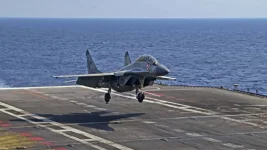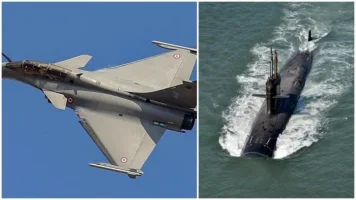- Views: 4K
- Replies: 21
India's recent agreement to purchase 26 Rafale-Marine (Rafale-M) fighter jets from France, valued at approximately €7 billion and reportedly signed on April 28, 2025, has brought renewed attention to a significant technical challenge: the aircraft's compatibility with the Indian Navy's existing aircraft carriers, INS Vikrant and INS Vikramaditya.
The core issue lies with the Rafale-M's 11-meter wingspan and non-folding wings, which may struggle to fit into the narrower aircraft elevators on both carriers.
This discrepancy has prompted considerable discussion among defence analysts and on social media platforms, with suggestions that the Rafale-M might be more suitably deployed on the forthcoming Indigenous Aircraft Carrier-2 (IAC-2), anticipated to feature wider elevators.
This article examines the technical limitations, potential operational impacts, and strategic decisions surrounding this procurement.
The agreement with France encompasses 22 single-seater and four twin-seater Rafale-M aircraft. The package also includes simulators, armaments, and a five-year Performance-Based Logistics (PBL) agreement. This deal followed successful ski-jump takeoff demonstrations by the Rafale-M at the Shore-Based Test Facility (SBTF) in Goa during 2022.
The primary aim of acquiring these 4.5-generation fighters is to replace the Indian Navy's ageing MiG-29K fleet, which has reportedly faced serviceability issues, with figures cited as low as 15–47% in 2016.
The Rafale-M is equipped with advanced avionics, including an RBE2 Active Electronically Scanned Array (AESA) radar optimized for maritime operations, and can carry advanced weaponry like the Meteor Beyond Visual Range (BVR) missile, thereby enhancing India's naval air capabilities in the Indian Ocean region against potential threats.
However, the acquisition has revived concerns regarding the Rafale-M's physical fit with India's current carriers. These vessels were initially designed to operate the smaller MiG-29K, which has a wingspan of 11.99 meters that can be folded to 7.8 meters for easier handling and storage.
In contrast, the Rafale-M's 11-meter wingspan is fixed. Public discourse, exemplified by a post on X (formerly Twitter) by user Iyervval on April 28, 2025, pointed out, "Rafale Marine has a wingspan of 11 meters. The wings can’t be folded. Vikramaditya’s elevator is 9.9 meters wide & Vikrant’s is 10 meters. Neither can properly deploy the Rafale.”
This has led to speculation that the full operational potential of the Rafale-M may only be achieved with the commissioning of IAC-2, projected for around 2035–2036.
The elevators on INS Vikrant and INS Vikramaditya are crucial for moving aircraft between the hangar deck and the flight deck. INS Vikrant, commissioned in 2022, features two deck-edge elevators, each approximately 10 meters wide and 16.5 meters long, designed for aircraft like the MiG-29K and the naval version of the Tejas (with an 8.2-meter wingspan).
INS Vikramaditya, a modified Russian carrier, has a single centre-deck elevator measuring about 9.9 meters in width, also tailored for the MiG-29K. The Rafale-M’s non-folding wings are wider than these elevator dimensions, posing a clear logistical hurdle.
To accommodate the Rafale-M on a 10-meter wide elevator, the aircraft would need to be manoeuvred diagonally, tilting it so one wingtip is raised while the other is lowered. Estimates suggest this would require a tilt of about 23.5 degrees. Such an operation could raise the elevated wingtip approximately 4.3 meters above the elevator floor, assuming the lower wingtip is flush with the elevator's edge. This presents several complications:
- Hangar Clearance:The typical hangar ceiling height of 5–6 meters might not be sufficient for the tilted aircraft, especially during maintenance tasks like engine replacement when the aircraft (Rafale-M standard height: 5.34 meters) is jacked up.
- Elevator Integrity: The effective width of the elevator might be slightly less than stated due to structural components, potentially requiring a greater tilt and increasing the risk of damage to the aircraft or elevator.
- Operational Speed: The process of carefully tilting and moving each aircraft would be time-consuming, likely reducing the carrier's sortie generation rate, a critical factor during high-intensity combat situations.
In the selection process, the Rafale-M was chosen over competitors like the Boeing F/A-18 Super Hornet, which has a larger wingspan of 13.62 meters but features wings that fold to 9.32 meters. This narrower folded width would allow the Super Hornet to fit Vikrant’s elevators with minimal issues and Vikramaditya’s with some modifications.
The Indian Navy's preference for the Rafale-M is reportedly due to its high degree of commonality (around 80% shared components) with the 36 Rafales already in service with the Indian Air Force, its advanced weapon systems, and France's agreement for Transfer of Technology (ToT) for potential local manufacturing. While Dassault Aviation made modifications for ski-jump compatibility, including reinforced landing gear, the fixed wingspan issue was not addressed.
The difficulty in moving Rafale-M jets to and from the hangar is expected to slow down operations, potentially limiting the carrier's capacity to sustain a high number of flights per day. This could be a significant disadvantage in any conflict scenario where rapid aerial response is paramount.
Furthermore, complex maintenance tasks like engine swaps, which require ample overhead clearance, might become impractical within the confined hangar space, possibly forcing such activities to be conducted on the flight deck, exposing them to weather conditions and enemy observation.
As a consequence, INS Vikrant, designed to accommodate up to 26 fighter aircraft, might operate a smaller contingent of Rafale-Ms, perhaps 14 to 18, to maintain a reasonable operational tempo. The remaining capacity could be filled by helicopters such as the MH-60R or Ka-31.
An alternative could be to keep most Rafale-Ms stationed on the flight deck, thus bypassing frequent elevator use. However, this approach would limit hangar space available for maintenance and expose the aircraft to the corrosive maritime environment for extended periods.
These operational constraints have led some defence analysts to suggest that the Rafale-M will only achieve its full operational capability aboard the planned 65,000-tonne IAC-2. This future carrier, intended to replace INS Vikramaditya by 2035–2036, is expected to be designed with larger elevators specifically to handle aircraft with non-folding wings.
Despite these well-documented concerns, some sources suggest the elevator issue might not be insurmountable. For instance, a social media post by rockfish31 on April 28, 2025, claimed that INS Vikrant’s elevator dimensions are actually closer to 16.5 x 11.2 meters, which would be sufficient for the Rafale-M. However, there has been no official confirmation of these larger dimensions from the Indian Navy.
Other proposed operational workarounds include:
- Diagonal Positioning:Consistently using the tilting manoeuvre, as reportedly demonstrated by the French Navy on their carrier, Charles de Gaulle, which has elevators around 11.5 meters wide.
- Deck Storage: Minimising elevator use by keeping most aircraft on the flight deck, despite the corrosion and maintenance limitations.
- Temporary Modifications: Considering retrofitting INS Vikrant’s elevators to increase their width by 1–2 meters. However, this would likely be a costly and complex undertaking (estimated at $100–200 million) involving significant structural redesign and would take the carrier out of operational service for 1–2 years.
- Leasing Additional Rafale-Ms: Utilizing land-based Rafale-Ms at naval air stations like INS Hansa for training purposes to reduce the operational load on carrier-based units until IAC-2 becomes available.
- Prioritizing TEDBF: Accelerating the development of India's indigenous Twin Engine Deck Based Fighter (TEDBF), which is being designed with folding wings, to potentially replace the Rafale-Ms on Vikrant and Vikramaditya by 2035, though project delays are a common concern.
Therefore, the most probable course of action appears to be managing the Rafale-M deployment with operational limitations on INS Vikrant and potentially INS Vikramaditya, until the larger elevators of the future IAC-2 provide a more comprehensive solution.


